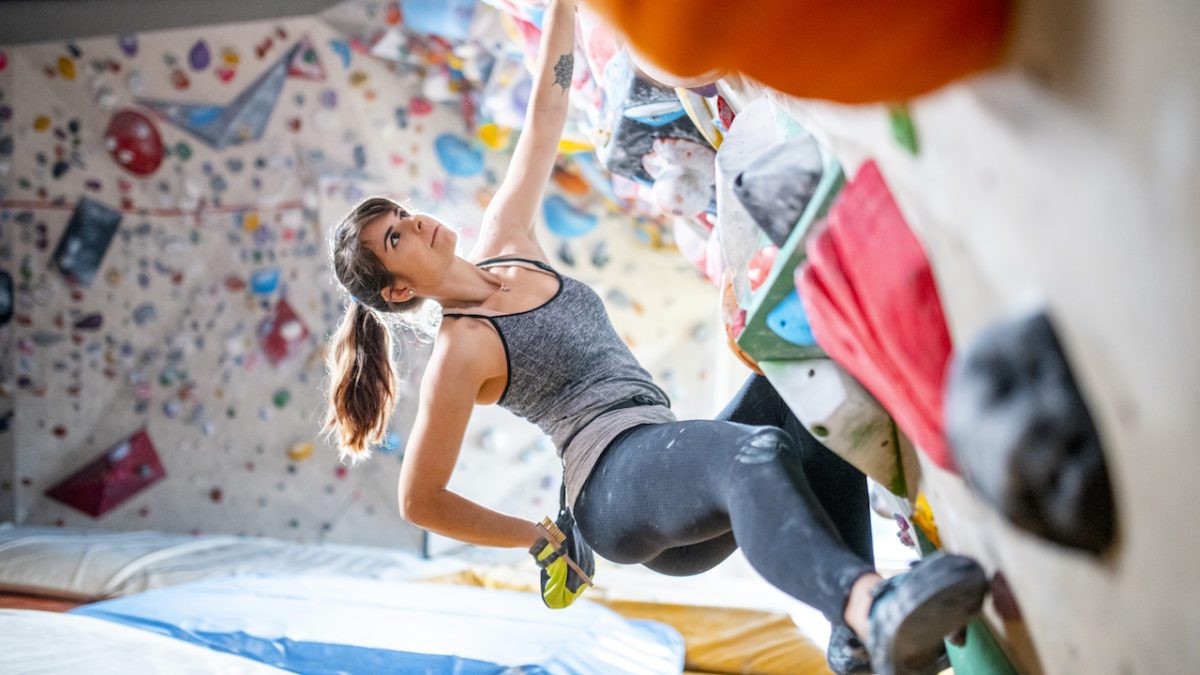How to Train Endurance in a Bouldering Gym
There are many ways to train endurance, and using a rope does not have to be one of them. Learn how to better your endurance on a boulder wall

Bouldering gyms make up most new climbing gyms in the North America. The smaller space requirements make it an ideal solution for urban climbers, while the low-training barrier makes it accessible to brand new climbers. While many more people have access to climbing gyms, an increasing number of climbers don’t have access to regular rope climbing. As such, can a person get better at rope climbing through bouldering? Is it necessary to train endurance on a rope?
Endurance
In some ways, yes. If you do not have experience with the ins and outs of rope climbing, learning how to lead, practicing the head game required to accel, and pushing past the fear implicit in that process all describe necessary portions of rope training that cannot be replicated in a bouldering gym. On the fitness side of things, the answer is not so clear.
Training Endurance on a Bouldering Wall
While a person may not be able to escape endurance training entirely, they may find themselves capable of completing such training in their bouldering gym. A few exercises stand out as optimal solutions to the endurance problem.
The first is called stick game. This exercise is best completed with a partner who has a gauge of your strengths and weaknesses. With a stick or a laser pointer, they will point out holds on a spray wall or bouldering wall, forcing you to climb through moves as you see them. Not only does this exercise push the climber to try movements they may not otherwise embrace, is also a fun training exercise that doesn’t become boring.
The second is boulder link-ups. Take a section of wall and try and climb a large number of boulder problems without touching the ground. This exercise generally requires moving up a difficult boulder, down climbing an easier boulder, and then moving up another difficult boulder. This exercise can bet stretched or compressed based on the length of the route you’re training for.
The order of the problems will affect the difficulty of the exercise. As always, try and climb in a way that reflects the difficulty-progression of the route you’re training for. If your aim approaches general endurance training, then try and steadily increase the duration and difficulty of the problems you’re climbing on.
The third, as featured above, comes from setting a project on your local spray wall. Something long and challenging is worth working, especially when it is at an angle. It can teach you the necessary mental hurdles involved in sending a project, including remembering beta on a wall with so many options.
Training Power to Increase Endurance
Although fatigue follows power and endurance training, the two exercises can pair well together. Power training is engaged, while endurance training is comparatively passive. Working them at the same time can improve both once the initial fatigue of climbing such volume subsides.
The reason power training has value in endurance conditioning comes from a person’s ability to feel comfortable on bad holds. As we become stronger, the way we react to crimps, for example, changes. When we begin climbing, there is no such thing as a good crimp. Instead, we can only move on jugs. As we progress, we learn that there are gradations of good and bad holds, and as we strengthen, we find comfort in holds we once found impossible to grip.
Hold type (crimp, sloper, pinch) becomes secondary to the fact that we can move easily on holds that are not jugs. By increasing our power, especially though the fingers, the holds we find most comfortable change to include a larger variety of grips.
Taking this logical progression beyond endurance and into actual climbs, we find that power can take us far. Expanding from finger power into pulling power, we find that a climber can make great progress on a long climb by moving quickly.
This tactic is utilized by many competition climbers on the IFSC World Cup circuit. In fact, the new six-minute format of lead competition almost necessitates it. By moving quickly, a climber may make it past their endurance crux. With that said, a climber can only move quickly if they have power to spare.
Furthermore, if we are focusing on progressing through sport climbs, we most note that endurance is not the only factor that keeps us from the top. Instead, difficult cruxes protect the finish of our projects. Having the ability to move through these cruxes easily, in isolation, means we need less endurance to climb the route’s crux from the ground.
For example, a V8 Moonboarder will not struggle on a 5.11a at a similar angle because the holds will be so good that they will not feel the crux. For them, the crux will be moving fast enough to complete the multi-move rope climb.
Take-Aways
Perhaps the takeaway is that progression on a rope is bigger than lapping the steep wall at your local rope gym. If you want to improve outdoors, labelling yourself a rope climber or a boulderer is not helpful. Instead, training power alongside endurance will likely produce the best long-term results.
If you want to push your level, working power is necessary. Otherwise, you will never push past the crux. If you work power, the rest of the holds will become easier to grip on your red point go. If you fail to work endurance, you may never climb at your limit on a rope. With that said, you don’t need a rope gym to push your endurance for your next season.


